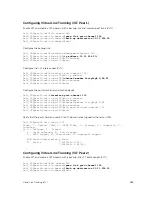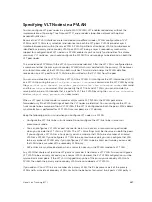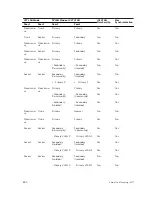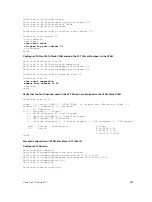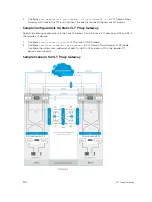
PVLAN Operations When a VLT Peer is Restarted
When the VLT peer node is rebooted, the VLAN membership of the VLTi link is preserved and when the
peer node comes back online, a verification is performed with the newly received PVLAN configuration
from the peer. If any differences are identified, the VLTi link is either added or removed from the VLAN.
When the peer node restarts and returns online, all the PVLAN configurations are exchanged across the
peers. Based on the information received from the peer, a bulk synchronization of MAC addresses that
belong to spanned PVLANs is performed.
During the booting phase or when the ICL link attempts to come up, a system logging message is
recorded if VLT PVLAN mismatches, PVLAN mode mismatches, PVLAN association mismatches, or PVLAN
port mode mismatches occur. Also, you can view these discrepancies if any occur by using the
show
vlt mismatch
command.
Interoperation of VLT Nodes in a PVLAN with ARP Requests
When an ARP request is received, and the following conditions are applicable, the IP stack performs
certain operations.
• The VLAN on which the ARP request is received is a secondary VLAN (community or isolated VLAN).
• Layer 3 communication between secondary VLANs in a private VLAN is enabled by using the
ip
local-proxy-arp
command in INTERFACE VLAN configuration mode.
• The ARP request is not received on the ICL
Under such conditions, the IP stack performs the following operations:
• The ARP reply is sent with the MAC address of the primary VLAN.
• The ARP request packet originates on the primary VLAN for the intended destination IP address.
The ARP request received on ICLs are not proxied, even if they are received with a secondary VLAN tag.
This behavior change occurs because the node from which the ARP request was forwarded would have
replied with its MAC address, and the current node discards the ARP request.
Scenarios for VLAN Membership and MAC Synchronization With VLT Nodes
in PVLAN
The following table illustrates the association of the VLTi link and PVLANs, and the MAC synchronization
of VLT nodes in a PVLAN (for various modes of operations of the VLT peers):
Table 60. VLAN Membership and MAC Synchronization With VLT Nodes in PVLAN
VLT LAG Mode
PVLAN Mode of VLT VLAN
ICL VLAN
Membership
Mac
Synchronization
Peer1
Peer2
Peer1
Peer2
Trunk
Trunk
Primary
Primary
Yes
Yes
Trunk
Trunk
Primary
Normal
No
No
Trunk
Trunk
Normal
Normal
Yes
Yes
Virtual Link Trunking (VLT)
889
Summary of Contents for Z9000
Page 1: ...Dell Configuration Guide for the Z9000 System 9 7 0 0 ...
Page 80: ...grub reboot 80 Management ...
Page 128: ... 0 Te 1 1 Te 1 2 rx Flow N A N A 128 Access Control Lists ACLs ...
Page 491: ...Figure 70 Configuring OSPF and BGP for MSDP Multicast Source Discovery Protocol MSDP 491 ...
Page 496: ...Figure 73 MSDP Default Peer Scenario 1 496 Multicast Source Discovery Protocol MSDP ...
Page 497: ...Figure 74 MSDP Default Peer Scenario 2 Multicast Source Discovery Protocol MSDP 497 ...
Page 498: ...Figure 75 MSDP Default Peer Scenario 3 498 Multicast Source Discovery Protocol MSDP ...
Page 760: ...Figure 100 Single and Double Tag TPID Match 760 Service Provider Bridging ...
Page 761: ...Figure 101 Single and Double Tag First byte TPID Match Service Provider Bridging 761 ...









